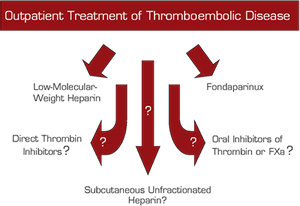In this multi-institution trial, 708 patients were randomized to receive a fixed dose of unfractionated heparin subcutaneously (333 U/kg initial dose followed by 250 U/kg every 12 hours) or low-molecular-weight heparin (100 IU/kg every 12 hours). Nineteen percent of the patients in both treatment groups had pulmonary embolisms at enrollment into the trial. After a few days of treatment, all patients were transitioned to standard warfarin therapy for three months. Approximately 70 percent of patients in either arm of the trial remained as outpatients for the entire length of the study. Recurrent thromboembolism occurred in 3.8 percent of the 345 unfractionated heparin-treated patients, and in 3.4 percent of the 352 low-molecular-weight heparin-treated patients. This met the non-inferiority primary objective of the study. The rate of major bleeding was also similar in the two treatment strategies (1.1 percent in those treated with unfractionated heparin, and 1.4 percent in those treated with low-molecular-weight heparin). There were no patients who developed heparin-induced thrombocytopenia in this study. Therefore, in this one trial, it appears that a fixed dose of unfractionated heparin (not monitored for aPTT) was as efficacious and safe as low-molecular-weight heparin.
In Brief
Metanalysis of multiple trials has demonstrated that subcutaneous administration of unfractionated heparin is actually superior to the more commonly used intravenous delivery1 . However, these previous trials adjusted the dosage of subcutaneous heparin based on aPTT monitoring. The need to monitor the aPTT several times a day has prevented the widespread use of subcutaneous unfractionated heparin for outpatient treatment of thromboembolic disease. However, there is substantial literature that suggests that aPTT results do not correlate well with either recurrent thromboembolism or bleeding. This implies that a fixed dosage of subcutaneous unfractionated heparin might be appropriate for the initial treatment of deep vein thromboses or pulmonary embolisms. Consistent with this idea, a few small trials have suggested that fixed doses of subcutaneous unfractionated heparin can lead to good outcomes2,3 . However, it is notable that all of these trials (including the recently published JAMA article) converted the subcutaneous therapy to oral warfarin within a few days. Therefore, it is not known whether prolonged administration of a fixed dose of subcutaneous unfractionated heparin is either safe or effective.
There is now an ever-increasing variety of pharmacologic products that may be appropriate for the outpatient treatment of thromboembolic disease (Figure). Low-molecular-weight heparin and fondaparinux can easily be used for this indication. There is a small amount of data supporting the use of subcutaneous direct thrombin inhibitors (such as hirudin) for outpatient anticoagulation. Oral inhibitors of Factor IIa (such as dabigatran etexilate) and Factor Xa (such as Rivaroxaban) appear to be promising antithrombotics. The data by Kearon and colleagues suggests that standard unfractionated heparin may be able to compete with these pricey alternative agents. Does this mean that we can all use a heparin preparation that is approximately one-twentieth the cost of low-molecular-weight heparin? Not yet, but there may still be another life left for our old friend unfractioned heparin.
References
Competing Interests
Dr. Abrams has served as an ad hoc consultant to GlaxoSmithKline and Portola Pharmaceuticals.

